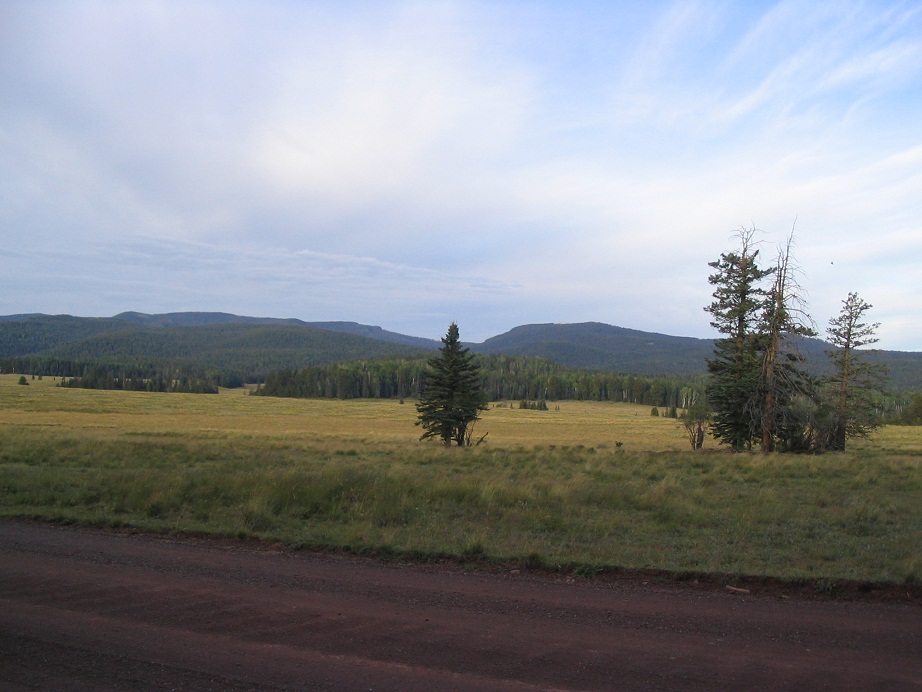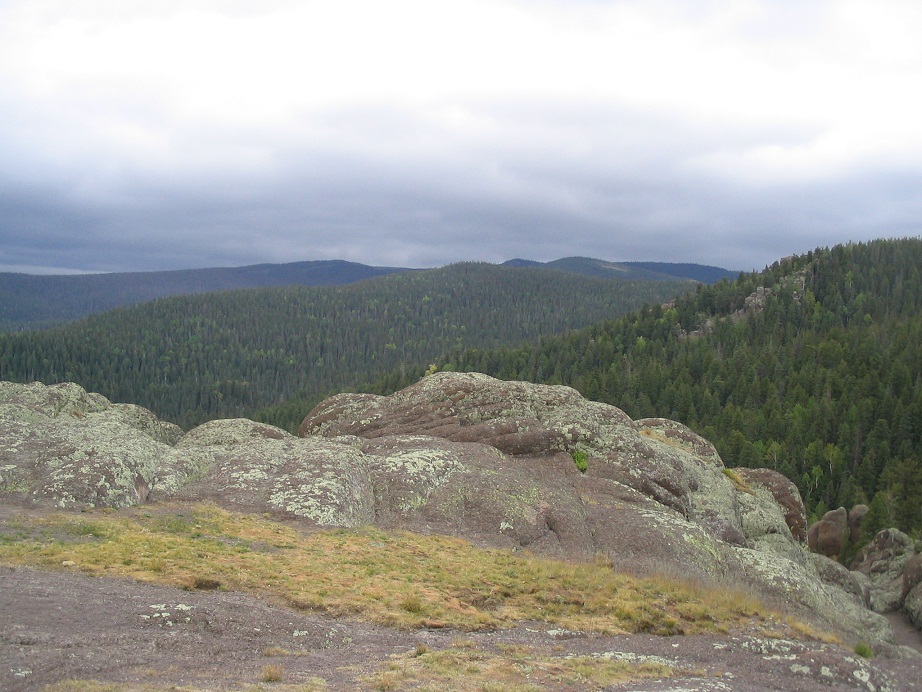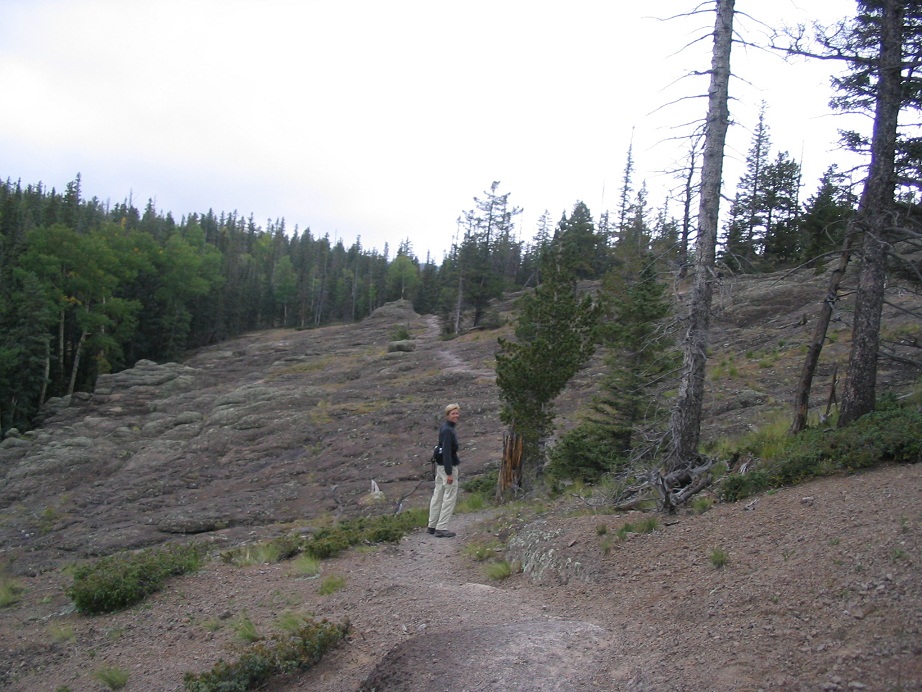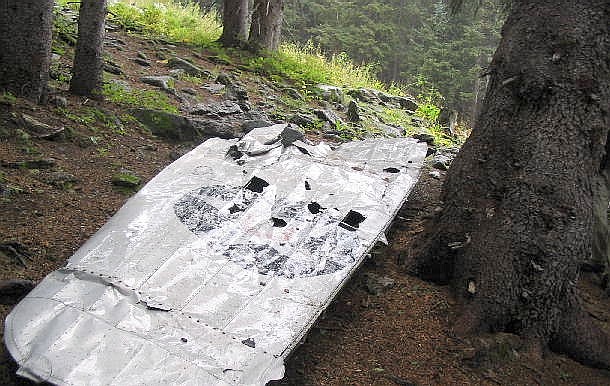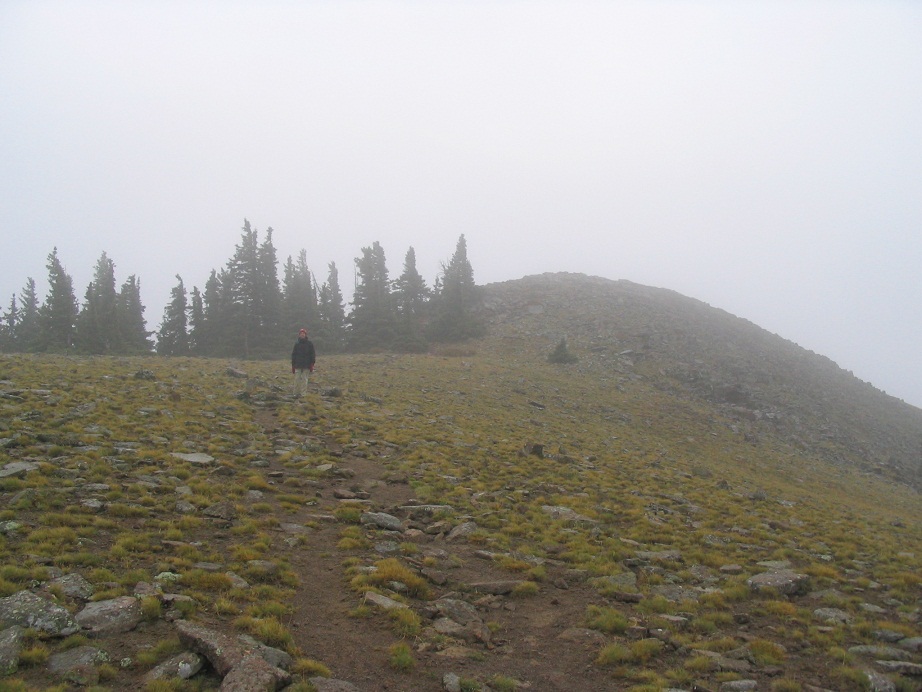
The Mountains of Arizona
• www.surgent.net
|
| Mount Baldy • Baldy Peak & North Ridge |
• Highpoint: White Mountains • Highpoint: Mount Baldy Wilderness • Highpoint: Fort Apache Indian Reservation • Highpoint: Apache County |
|
Dates: (1) June 24, 2000; (2) September 19, 2004
• Elevation: 11,403+ feet
• Prominence: 4,703+ feet
• Distance: 14-16 miles
• Time: 7 hours
• Gain: 2,200 feet
• Conditions: Sunny and puffy clouds in 2000, stormy with low cloud ceiling in 2004
Arizona
•
Main
•
AZ P1K
•
PB • LoJ
•
Interactive map
Mount Baldy is the highest peak of the White Mountains of Eastern Arizona. It is volcanic in origin, built up over the eons by repeated flows and other forces of geology. Thus, it is more broad than high, and surrounded by hundreds of single-event volcanic mounds, all comprising the Springerville Volcanic Field.
The sprawling mountain and its hundreds of foothills dominate eastern Arizona's topography. The elevations are higher on average than anywhere else in the state, and snow falls here earlier, and stays longer, than other locations. Arizona's coldest temperature on record, -40 degrees (F and C) happened here in January 1971, at Hawley Lake.
The Little Colorado River's headwaters begin here, as two separate streams both emanating from the eastern slopes of Mount Baldy. Later on, they connect to form the Little Colorado River, which merges with the Colorado River on the east end of the Grand Canyon. The two main trails to the summit parallel these individual streams.
The Fort Apache Indian Reservation encompasses a significant portion of the White Mountains. Mount Baldy itself (Baldy Peak), elevation 11,403 feet, is a sacred summit to the Apache. The peak is officially off-limits to the public. A ridgepoint a few hundred yards to the northeast is slightly higher, and lies on the boundary of the Reservation, with the Mount Baldy Wilderness sharing the boundary. Thus, this peak is publicly accessible.
Recent maps, however, muddy this issue. They show the boundary to be offset a couple hundred yards to the east, placing the north ridge inside the Indian Reservation. I believe this is an error. Older maps were rendered in the NAD-27 datum, while newer maps are rendered in the WGS-84 datum. The two datums differ by a couple hundred feet in the east-west direction. I suspect the waypoints that were taken in the NAD-27 datum were replotted in the WGS-84 datum, accounting for this odd shift in the boundary.
I mention all this because I think it's an important distinction to make. This places the north ridge --- the probable highpoint --- within the Indian Reservation, which would then make it also publicly inaccessible. The older Mount Baldy Wilderness maps (dated about 1970) show the boundary to be exactly on the north ridge. This is common practice, to place boundary waypoints on ridgelines. Shifting the boundary to a slope seems odd. Frankly, I would suggest that you carry this older version of the map, and in the rare case someone stops you, argue your point using the map in hand. Then run.
I have been to the summit twice, once in 2000, and again in 2004. Both times, I visited both peaks.
First Visit, June 2000: I was down to one remaining highpoint needed to complete the 15 Arizona county highpoints when I got my act together enough to plan a trip east to the White Mountains for a hike up Baldy. I left home at 3 p.m. on Friday after work, driving to the Mount Baldy Wilderness Area via Globe and Show Low, arriving at 7:30 in the evening. I drove through a lot of rain from the monsoon storms around Show Low. The weather began clearing, but when I arrived at the Winn campground, the roads were muddy and there were many puddles.
I awoke the next morning at 4 a.m. to clear skies and cool temperatures. I broke camp, ate breakfast and drove to the West Baldy Trailhead. I began my hike at 4:45 a.m., the sky still a deep purple. The first mile loses about 200 feet of elevation, descending toward the stream. I spooked a herd of elk grazing in the small meadow, and they all took off into the trees except for one big guy who stared me down until I was about 100 feet from him. I clapped my hands and made "whoop" noises, and he finally joined his buddies in the trees.
The next three miles are level, paralleling the West Fork of the Little Colorado. The route alternates between open meadow and small stands of trees, and gains about 600 feet overall. I made excellent time on this part and had covered the first four miles in a shade over an hour. The meadows grew larger and larger the farther in I walked. The scenery was lovely.
After 4 miles, the trail enters the forest for good. It begins a gradually steeper ascent for the next mile, then crosses a drainage. About the sixth mile, the route gains about 600 feet, coming to a series of long (and in places, steep) switchbacks. These switchbacks get over a band of cliffs and outcrops, and covers about a mile. The last mile is along a pleasant grade through the trees, before coming out to the main ridge north of the summit, elevation 11,200 feet. The junction with the East Baldy Trail comes a few minutes before reaching the open ridge.
I was now about a quarter-mile north of the north summit. In 2000, it was perfectly legal to continue up-trail onto the northern ridge. So I proceeded upward, gained the last 200 feet and arrived on top at 8:00 a.m. The ridge is topped by a few large cairns, but is mostly bare of trees. Views in all directions were outstanding.
I got out my sight level and looked over at Baldy Peak. Without the level, Baldy Peak, with its pointier profile, looks higher, and without surrounding contextual clues, you'd swear it was about 10 feet higher. But it's not. I felt strongly that where I was, on the north ridge, was higher than Baldy Peak by about three feet. Then I had an ethical dilemma: do I run on over to Baldy Peak? I hiked down to the saddle spearating the two peaks. There is a sign there about the Reservation, but nothing said the peak was off limits. I decided my intentions were pure and in the spirit of scientific discovery, so I hustled up to its top and sighted back with my level to the north ridge and again felt the north ridge was higher. I did not stay more than a few moments. I descended back to the saddle, back on "legal" land.
I reascended the north ridge, then down again, starting the long trek out. I stopped in a meadow and had an early lunch, then marched out the remaining miles back to my truck, exiting at 11 a.m. I had not seen a single person all day, but then about half-way out, I saw lots of hikers. Most were day hikers but a few looked like they were going in far, possibly to the top.
I was pleased to be successful and happy to complete the county highpoints, which was an amusing project, one that I enjoyed very much. I drove home to Phoenix that afternoon, encountering lots of rain around Show Low.
Second Visit, September 2004: We arrived to the Winn Campground in the dark, and I was able to erect the tent using my truck's headlights. Otherwise, the night was clear but completely dark. The elk bugled all night, their other-worldly bugling needing to be heard to be believed. The night was not without drama. I tripped over a rock and landed hard on the ground, thinking I'd broken my arm because it hurt so bad. I hadn't broken it, but I moaned anyway.
The night was kind of fitful. Neither of us slept well. The elk never shut up, and furthermore, a big wall of clouds had moved in, the edge of a gigantic hurricane that was breaking up over the southern tip of Baja California, over a thousand miles away. We were up well before dawn, and we discussed our options. The weather would be the biggest variable.
We decided to go for the hike, figuring we could turn back if things got bad. We started from the East Fork Trailhead and were on the trail at 7:20 a.m., the sky a deep gray, but still. Winds were light and it was humid, but not rainy or even drizzly. The first mile was level through open meadow. We met up with another hiker and his two big dogs. Soon, we entered into the forest and zig-zagged in and out of drainages before coming to a tight switchback. We walked up and stopped near some cliffs and spires, where we took our first break. I figured we'd covered slightly less than 2 miles in about 45 minutes.
We heard distant thunder. Obviously, this concerned us. But on the other hand, there was no rain, the clouds weren't really that low, and despite the appearances, things seemed to be stable. So we decided to hike another hour and see how things went. The trail gained moderately with a few level stretches through forest. In one area it crossed a few rocky outcrops. Actually, we made good progress, and we stopped after another hour, having covered over 5 miles from the truck. The weather was holding steady. Just cool, cloudy and gray.
After our second break we made a decision to go for it. We were close, feeling good, and the weather was still more bark than bite. As we hiked the remaining two miles in an intermittent drizzle, we met a couple of hikers and a whole team of people on horseback. The thick forest helped keep us reasonably dry, but crossing some open areas we got wet in the steady rain.
We arrived at the trail junction near the ridge, and hiked up the final grade to the north summit. Despite the feeling that it probably is higher than Baldy Peak to the south, Baldy sure looked higher, so we hiked to it, following the fine trail to its summit. We stayed briefly, but the fog rolled in thick so we descended and started our slog out. We took an extended break at the saddle between the summits.
The hike out went fast. The rain subsided and the clouds broke up, giving us sun for the last few miles back to the truck. After changing and resting, we drove out through Greer, then back to Show Low where we stayed at a hotel. We had a dinner at Licano's Mexican Lounge, and watched as the rain finally started to drop in a torrent. The next day, we drove home, forced to make a 50-mile detour through Globe after mudslides wiped out part of the Beeline Highway between Payson and the Phoenix area.
Update: Highway AZ-273 is now paved to the trailheads (and beyond), and the East Fork trailhead is now paved too.
|
|
